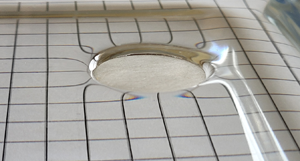No CrossRef data available.
Article contents
Stable orientations of small-scale floating cylinders
Published online by Cambridge University Press: 26 October 2023
Abstract

A coin always floats in stable equilibrium with its longitudinal axis normal to the air–liquid interface. In contrast, a long thin cylindrical pin floats with its longitudinal axis parallel to the air–liquid interface. In this context, we present a theoretical investigation of the stability of small-scale hydrophobic cylinders floating in vertical and horizontal orientations at various aspect ratios (length/diameter). The study is limited to cylinders denser than water floating at the air–water interface. Our analysis shows that, unlike large-scale vertically floating cylinders, the stability of vertically orientated small-scale cylinders increases with an increase in aspect ratio. A similar trend is observed in the stability of small-scale horizontal cylinders. We also explain the underlying mechanics that leads to a rise in the stability of floating cylinders with an increase in aspect ratio. Unlike large-scale floating cylinders with uniform density, we show that the effect of governing forces (weight, buoyancy and surface tension) in small-scale cylinders changes from a stabilising to a destabilising force with a change in the aspect ratio. For example, in the case of a vertically floating cylinder, the buoyancy force acts as a stabilising force at a small aspect ratio whereas, at large aspect ratios, the buoyancy force has a destabilising influence. Likewise, the body's weight has a destabilising influence at a small aspect ratio and stabilising effect at a large aspect ratio. The reason behind this transformation is that, above a particular aspect ratio, the centre of gravity of small-scale floating cylinders lies below the centre of buoyancy.
JFM classification
- Type
- JFM Papers
- Information
- Copyright
- © The Author(s), 2023. Published by Cambridge University Press





